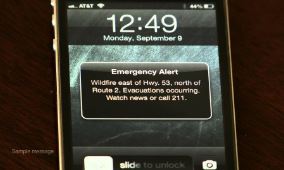
CCA agrees with large carrier association CTIA that integration of new WEA geo-targeting capabilities into networks and devices will take at least 36 months from the effective date of new rules. Smaller wireless carriers will need an additional 12 to 24 months because they don’t “have the same access to the latest devices on the same timeline as the largest carriers, if at all,” CCA EVP/General Counsel Rebecca Murphy Thompson recently told the agency’s Public Safety and Homeland Security Bureau.
As the agency develops rules for updating WEA, CCA agrees with the FCC that refining the delivery location of the alerts will improve the quality of information that consumers receive during disasters and emergencies, limit network congestion, and reduce the potential for over-alerting. But CCA is concerned “there appears to be inconsistent evidence about the technical capability of all carriers to achieve the FCC’s enhanced WEA goals. It would defy logic for the Commission to adopt rules that are technically infeasible,” Thompson writes in a summary of the discussion viewed by Inside Towers.
That could result in “dozens” of carriers seeking waivers of “overly-ambitious rules, or worse, carriers opting-out of the voluntary WEA program,” according to the CCA executive. She urged the Commission to take more time to determine what is feasible.
CTIA told the FCC in December that enhancing geo-targeting capabilities for WEA “represents a fundamental shift” in WEA’s design and use that will require “new mobile wireless network and device standards” and “new or modified technologies and practices for alert originators.” CTIA called 36 months for implementation an “aggressive, yet achievable” timeline, according to a summary of the discussion by CTIA Assistant VP Regulatory Affairs Matthew Gerst.
However those alert originators affected by the California wildfires want the improvements to happen faster. Dianne Jacob, Chairwoman of the San Diego Board of Supervisors, told the FCC last week that its AlertSanDiego evacuation notification system that relies on landline phone numbers is becoming less relevant with the proliferation of mobile phones. Yet WEA “is largely impractical for major metropolitan areas. Imprecise geo-targeting is preventing WEA from becoming a primary alert and warning system — putting lives at risk,” she states in a letter. She supports a mandate that wireless carriers deploy a geo-targeting WEA software update for mobile phones by May 2019 “at the latest.”
Michael Antonucci, Emergency Services Manager for San Bernardino County Fire, agrees, calling geo-targeting for WEA a “must have.” It’s technically feasible and “paramount” to public safety, he writes. The lack of geo-targeting for WEA is “putting lives unnecessarily at risk in the very jurisdictions most likely to experience catastrophic disasters,” he wrote to the Commission last week.
By Leslie Stimson, Washington Bureau Chief, Inside Towers
January 8, 2018




Reader Interactions